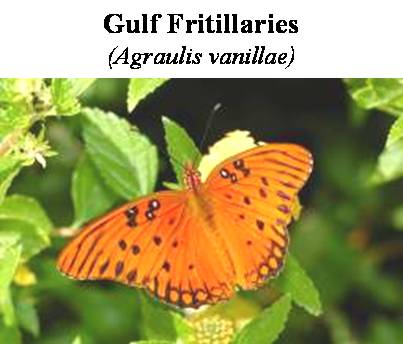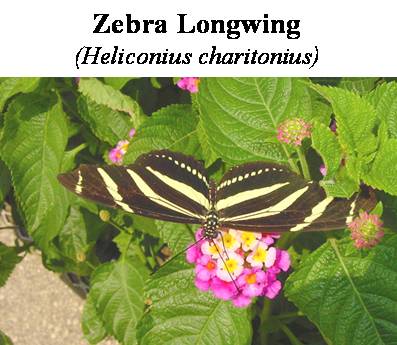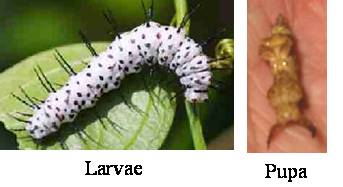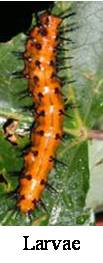This family is made up of several butterflies that reside in Florida. The two most commonly seen in the Venice area are the Zebra Longwing and the Gulf Fritillaries. Several others are also found in the southern area of the State. The Zebra longwing was, on April 26, 1996, declared to be the Florida State Butterfly. (The Gulf Fritillaries is not a member of the Fritillaries family but a member of the Longwing family.) Both butterflies use the Passion Flower vine as Larval Host plants. If the Passion vine is in the sun, the Gulf Fritillaries will lay eggs on it. If the Passion vine is somewhat in the shade, the Zebra Longwing will use it for its egg/larval host plant.
Longwing Family
Reproduction of the Zebra Longwing is initiated by the male who searches for females in order to mate. After mating takes place, the male will expel a chemical onto the female that repels other males in the roost. On average, groups of 5-15 eggs, the size of a pin head, are laid on the leafs of host plants such as the Passion vine. The larva matures into caterpillars nourished by eating the leaves of a host plant and during this stage the caterpillar eats continuously. The Zebra Longwing caterpillar has a pale yellow head and a long white body with pointed black spines on each body segment. As the caterpillar grows, it molts and sheds its exoskeleton after it reaches the right size after the caterpillar hangs upside down by a silken string from a branch until its internal structure changes. Within approximately 10-14 days an adult Zebra Longwing butterfly emerges and continues to hang upside down to pump blood into it's newly formed wings in order to give expand them and then as soon as the wings are dry, the Zebra will fly away. Adult butterflies (Zebra) are long-lived and can survive up to 6 months with adequate nutrition. Zebra Longwing butterflies will die off in the northern winter months due to the freezing temperatures and recolonize by mid-summer when the climate is warmer.
Gulf fritillaries are one of four members of the longwing family found in Florida. They range throughout the southern U.S. and migrate northward during warmer months. They have been seen flying far from land over the Gulf of Mexico, hence the name. The medium-sized (2.5-3.0") bright orange butterflies are easy to spot in fields and gardens and along forest edges. They fly rapidly, usually within a few feet of the ground, fluttering along a fairly straight course. Gulf fritillaries roost near the ground, sometimes in groups. Gulf fritillaries prefer the nectar of red and white flowers, such as Spanish needles and Lantana. Some males sip mud which is called puddling. Host plants are Passiflora vines. The ribbed yellow eggs are usually laid singly. They become mottled with brown before hatching. Larvae are dark gray with lighter dots and reddish stripes, with two curved spines on the head and six rows of black branching spines along the body. The chrysalis, about an inch long, is curved and resembles a dried leaf.



The pupa of the Gulf Fritillaries is similar to the Zebra pupa to the left. Main difference is the much shorter “horns” of the Gulf Fritillaries.





